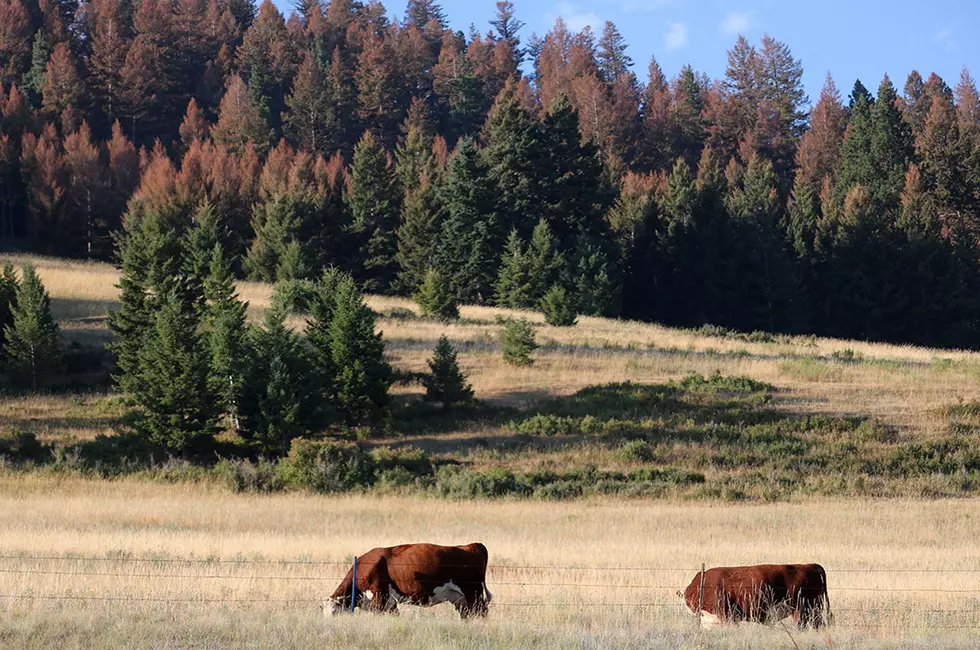
Tussock moths take a bite from South Hills fir stands; trees expected to recover
A moth is causing some conifers around Missoula to turn red, but most trees will probably bounce back next year.
Those who’ve been hiking the trails around Missoula have noticed some of the firs don’t look so good. The needles at their tops and branch tips have turned red or are gone altogether.
Five Valleys Land Trust spokeswoman Lena Viall said she has fielded several calls from people worried about the trees on Mount Dean Stone south of Missoula.
“There’s not too much around the Barmeyer Trail, it’s more on the western slopes. That’s private land, and we’ve been working with the landowners up there,” Viall said. “It happened so quickly.”
What happened so quickly is not a pine beetle outbreak, but an outbreak of Douglas fir tussock moths. And while it’s concerning, it’s far more benign, said August Kramer, forest pest specialist with the Montana Department of Natural Resources and Conservation.
“It’s one of those things that’s very apparent, it’s very visible,” Kramer said. “You can see it on pretty much any hillside that you look at in Missoula. You can see the damage, and it does look pretty serious. But it will take care of itself.”
Douglas fir tussock moths are native to western Montana but tend to be found only in certain areas, including Missoula, Kalispell, Columbia Falls and around Flathead Lake. The reason they’re limited is female moths can’t fly. The males must search them out.
That’s a good thing, because their offspring are voracious.
The female lays her eggs on the branches of Douglas fir and true fir trees, where they overwinter. After the caterpillars hatch in late May or early June, they start feeding on the tree, preferably the new needles. They’ll continue to eat until late July when they make a cocoon to morph into moths.
Normally, Missoulians aren’t aware of the moths because they are kept at bay, thanks to predators and disease. Chickadees love to eat moth eggs, and parasitic wasps also prey on the eggs.
But every now and then, the moth population takes off, probably due to a combination of factors.
“I think it’s been a while since there’s been an outbreak,” Kramer said. “We’ve experienced some drought years, and stressed trees are more susceptible, especially if conditions are chronic. So it could be a food source thing, it could be a climate thing - it’s hard to pinpoint the reason.”
Whatever the reason, moth larvae are hitting trees hard this year.
Moth caterpillars can move by playing out silk strands that catch the wind, though they can only travel a quarter mile at the most. But a few can also hitch rides on RV’s or boats. That could be how they’ve turned up in a few new places this summer, including Mount Dean Stone, Pattee Canyon and the Rattlesnake drainage.
But it’s only temporary.
The one other enemy of tussock moths is a disease: a nuclear polyhedrosis virus, to be exact. It, too, is always present but doesn’t kick in until the moth population gets large. Then, like a cold virus in a classroom of kindergarteners, it rapidly spreads through the population, knocking the moths back to lower levels for another few years.
“It’s what we call ‘eruptive population dynamics,’” Kramer said.
Kramer estimates the outbreak is in its second year. So by this time next year, it could be over.
But what about the trees?
Fortunately, many will revive with new growth in the spring.
“We recommend trying to manage for healthy trees and provide as many resources to the trees you have, whether it’s water or sunlight. Provide adequate spacing between trees, so they’re not competing too aggressively with one another,” Kramer said. “Just free them up to create their own defensive systems, because as bad as these trees look, most of them are going to be just fine.”
